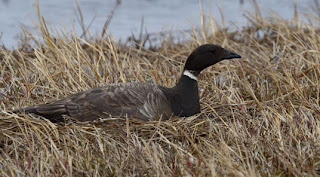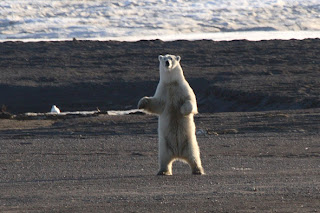Today was a day of rest. So a group of us headed out to Point Barrow mid morning were we had a fly over Long-tailed Jaeger, flocks of Long-tailed Ducks moving past along with the resident Glaucous Gulls at the whale carcass. As we arrived at the carcass a Polar Bear was wandering off over the ice shortly followed by a second that started of at the food source before moving off. A third bear was spotted distantly over the ice near the pressure ridges. 
Once back at the trailer we headed off in a truck first to Freshwater Lake where there were a group of 4 King Eiders, 3 Arctic Terns and a male Spectacled Eider but the biggest surprise was on the journey through Barrow when an immature Bald Eagle flew along the coast landing on the edge of the sea ice. We continued to the landfill were a short scan over the marsh to the north produced the white male Ruff along side a Buff-breasted Sandpiper. A flock of 30 Snow Geese flew over before a group a four Canada Geese were spotted alongside Middle Salt Lagoon.
20th June
Winter set in today as snow flurries were frequent but the fine dusting had no impact, high of –1 degree celsius. This was to be our last day of foot surveys so it was going to be a long day. We drove right to the end of Gaswell Road and then walked a further kilometre to our starting point. The survey started immediately with a flyover Peregrine and the finding of a White-fronted Goose. The tundra held all the common species such as Lapland Longspur, Semipalmated Sandpiper, Pectoral Sandpiper, Dunlin and Parasitic Jaeger. Approaching the half way point a Arctic Fox jumped up into view before heading out over a marsh where a group of five distant Sandhill Cranes could be seen. After a brief lunch stop we headed back north seeing a pair of Spectacled Eiders on a flooded pool, 2 pairs of Red-throated Loons and a single Western Sandpiper (first one for Barrow).
Arctic Fox
19th June
An easy day for a change as temperatures fell to a high of 0 degrees Celsius. Continuing my recovery from my prolonged cold I was given a short plot for the day. The plot circled a lake that held the usual Pacific Loon, Pintail and Long-tailed Duck as well as a nesting Black Brant on a small island. Further on and a female King Eider was flushed from her nest. On route back to Narl a pair of Spectacled Eiders frequented a roadside pool. 
Black Brant
18th June
The morning started as the fog rolled in, we headed out to the far end of Gaswell Road to another survey plot. With in the first few metres a bird appeared to my left, it was a large shorebird flying away thankfully it banked to reveal a long straight bill then all the plumage features confirmed a new world bird for me, a Hudsonian Godwit. The rest of the walk way very quiet with just a Pomarine Jaeger and 6 Spectacled Eiders.
After last night the two fox hunters headed to Point Barrow so I tagged along. The sun was out once again and on arrival we found a Polar Bear with a cub walking across the ice heading west. We follow them as the cub was having a great time running, sliding and generally playing across the ice as they moved. After a while a very distant bear appeared between the ice before disappearing again. The mum and cub that we think was maybe 2 years old (about 2/3 the size of the mother) did a big arch before heading back in towards the carcass. We stayed and watched them for a while feeding before leaving the to it as we headed back for bed. 
Polar Bear
17th June
Temperatures started to decrease towards zero as the days plot was relatively quiet as 1 pair Spectacled and 8 King Eiders were counted as were 2 Pomarine Jaegers. I however found my first Long-tailed Duck nest along with 2 Glaucous Gulls nests.
Braving the cold still with my illness I just couldn’t stay behind when the whole gang were off on an ATV ride to Point Barrow. Travelling the 4 miles or so along the coast heading northeast on the shingle beach the clouds cleared to leave a glorious evening. Arriving at the point we pulled up on the ridge some 200m from a rotting pile of whale carcass from the previous years hunting. Straight away there was a shout, “there out on the ice” I looked and immediately locked onto the reason behind the trip as a Polar Bear walked off away over the ice. WOW! I looked left to see a second bear feeding on the whale without a care in the world surrounded by a couple hundred Glaucous Gulls. Further scanning gained two distant animals out on the sea ice.
Polar Bear
After staring in amazement at the bears for some time we continued past the most northern point of Alaska out to Plover Point the actually tip of the spit. On our return to Point Barrow the bears had returned with 4 in close proximity of the land and a further three distantly out on the ice. We just couldn’t believe that there were 7 animals out on view, beyond our wildest dreams! One bear was so chilled out he spent the whole time flat out on his tummy on a small pressure ridge of ice in the distance. At the end of our stay the bear feeding on the whale started to wander a little towards us as he sniffed the air, coming a little closer he could not smell us so he rose up onto his back legs to get a better sniff (what an impressive beast, thankfully he was still a safe distance). Still nothing, he took a few steps closer and tried again, this time he figured us out and turned the other way back out onto the ice. Ecstatic with the experience we left the bears in piece.
Polar Bear
16th June
The survey area today took me north of Gaswell Road up to the coast of the Beaufort Sea. It was another long day with 3 Spectacled and 10 King Eiders seen as well as 60 Snow Geese that flew overhead. The nest tally included 3 White-fronted Geese, American Golden Plover, Red Phalarope and Semipalmated Sandpiper.
American Golden Plover
15th June
Today was the day I finally succumbed to one of the illnesses floating around the house but not to grumble we headed out to the days plot. It was a nice sunny calm day and straight away a new bird for the whole trip flew over in the form of two Snow Geese. A little further and a male Spectacled Eider jumped up in front, then a pair of Long-tailed Jaegers flew over low before giving amazing views as they walked over the tundra past a White-fronted Goose sitting tight on her nest. The 16km hike finished several hours later with a Buff-breasted Sandpiper. 
Long-tailed Jaeger
White-fronted Goose
























